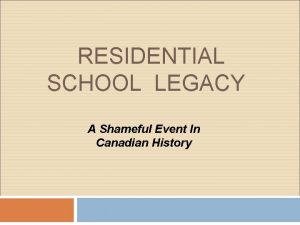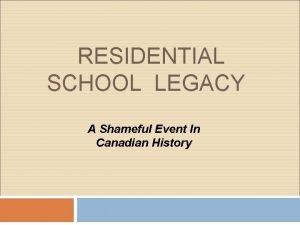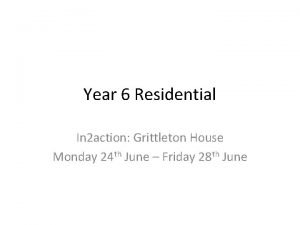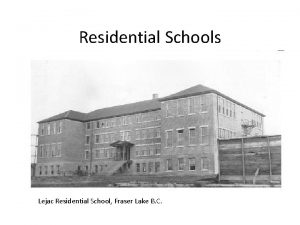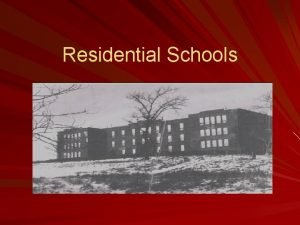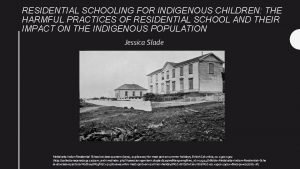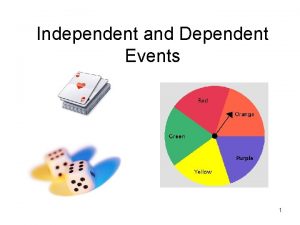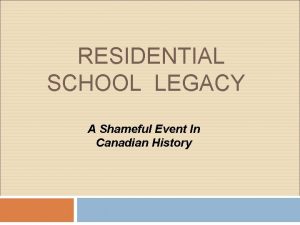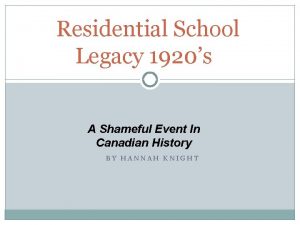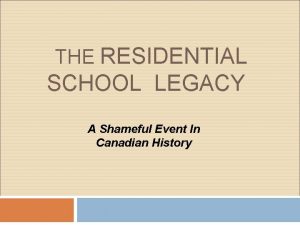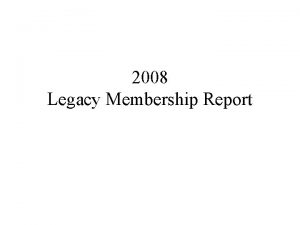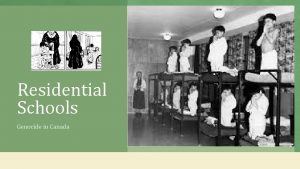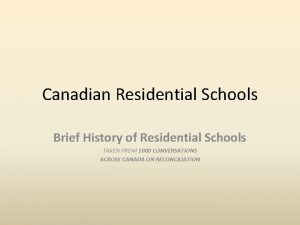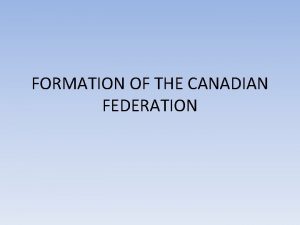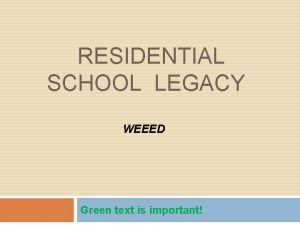RESIDENTIAL SCHOOL LEGACY A Shameful Event In Canadian

















- Slides: 17

RESIDENTIAL SCHOOL LEGACY A Shameful Event In Canadian History

Where Were They? Residential Schools were located all across Canada. In total there were 130 schools located across Canada.

Background From 1830 to 1996, Indian children were forcibly removed from their homes and taken to residential schools operated by religious orders. Some of these schools were situated right on reserves but most of the schools were far away from schools’ drawing area. Even though some residential schools were on reserves, the children attending these schools were not allowed to see their parents, relatives, or community members that lived on the reserve. The goal was to assimilate the children into white society.

The Schools The schools were located in almost every province in Canada. Except for PEI, New Brunswick and Newfoundland. There were 130 of them. Most schools closed by the mid 1970’s. The last school closed in 1996.

Attending The Schools The Indian Act stated it was mandatory for status Indians to attend residential school. Children as young as 6 would be removed from their families to attend school. They would have to stay their for 10 months every year.

They Could Not… Speaking their own languages was forbidden. They could not practice any of their cultural activities. They could not speak to other family members. If they did any of these things they would get physically punished.

When They Arrived… The students were only given one set of school clothes and one set of work clothes. The students were assigned daily chores. They were forced to get their hair cut very short, even for girls. The children got their names changed and they had to go by the names the staff gave them.

All Of The Beds Were Very Close Together

Classrooms

These Images Show A Young Boy Before And After Attending Residential School.

Quote from 1920 “I want to get rid of the Indian problem. Our object is to continue until there is not a single Indian in Canada that has not been absorbed into the pody politic, and there is no Indian question, and no Indian department … They are a weird and waning race … ready to break out at any moment in savage dances. ” -Stated by Duncan Campbell Scott – Deputy Superintendent General of Indian Affairs

Some Children Never Returned Home Some of the children ran away and never returned. When there was a virus going around a lot of children caught it because of the poor living conditions. This is a picture of a girl who never returned home, she passed away when cholera struck the her school in 1907.

The Survivors A lot of them missed their families and wanted to go home Some even tried to run away, most were found and returned to school Many suffered physical, emotional, and sexual abuse

Today In 2008, The Canadian Government, Assembly of First Nations and the Churches have agreed to sign a “Agreement in Principal” to financially apologize to the survivors. The payment the survivors get ($1. 9 billion in total) is based on how many years they attended school. Many survivors are still looking for healing while others do not like to talk about their experiences at residential school. The payments the survivors get, does not erase the wrong-doing that the federal government and churches did.

Rita Joe Biography 1932 -2007 Spent her childhood on a Mi’kmaq Reserve on Cape Breton Island Lived with foster families Sent to Shubenacadie Indian Residential School on mainland Nova Scotia when she was 12 Later married and raised 10 children

Biography Continued Rita Joe recalled being told constantly, at the residential school, “You’re no good. ” She began writing to challenge these negative messages. In the prologue to her memoir, Rita Joe states: “My greatest wish is that there will be more writing from my people, and that our children will read it. I have said again and again that our history would be different if it had been expressed by us. ”

I Lost My Talk I lost my talk The talk you took away. When I was a little girl At Shubenacadie school. You snatched it away: I speak like you I think like you I create like you The scrambled ballad, about my world. Two ways I talk Both ways I say, Your way is more powerful. So gently I offer my hand ask, Let me find my talk So I can teach you about me.
 Residential school photos show legacy cultural
Residential school photos show legacy cultural Residential school photos show legacy
Residential school photos show legacy In2action grittleton house
In2action grittleton house Burwardsley school trip
Burwardsley school trip Use of english
Use of english Tuberculosis in residential schools
Tuberculosis in residential schools Ob youtube
Ob youtube Metlakatla indian residential school
Metlakatla indian residential school Whats a sentinel event
Whats a sentinel event Simple or compound event
Simple or compound event Independent or dependent
Independent or dependent Independent vs dependent events
Independent vs dependent events Swot analysis of event venue
Swot analysis of event venue Event background
Event background General structure of news item
General structure of news item Pgl suffolk
Pgl suffolk Smart residential buildings
Smart residential buildings Before and after residential schools
Before and after residential schools
